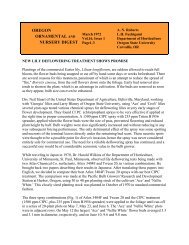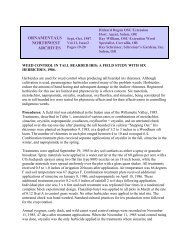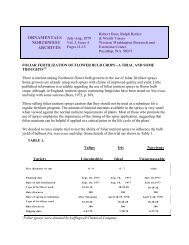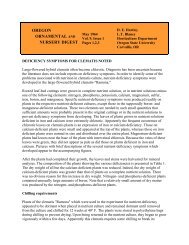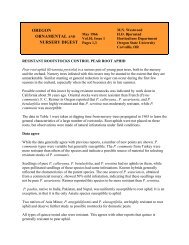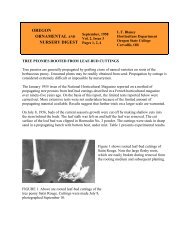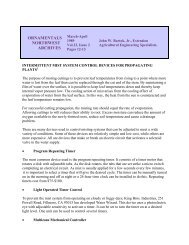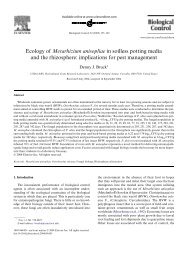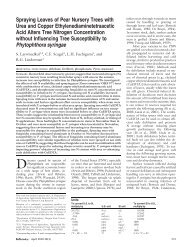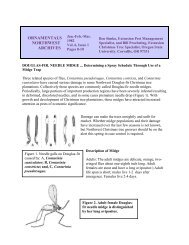Tomato Spotted Wilt virus and Western Flower Thrips: Update, Vol ...
Tomato Spotted Wilt virus and Western Flower Thrips: Update, Vol ...
Tomato Spotted Wilt virus and Western Flower Thrips: Update, Vol ...
Create successful ePaper yourself
Turn your PDF publications into a flip-book with our unique Google optimized e-Paper software.
TSWV frequently causes 50-90% crop losses in lettuce during any season of the year in Hawaii.TSWV has become a limiting factor in lettuce production in Hawaii, especially when fields arereplanted before all the thrips that have pupated in the soil after acquiring TSWV from theprevious crop have emerged. In field experiments in Hawaii, thrips continued to emerge from thesoil for 2-3 weeks after crop residues were plowed <strong>and</strong> rototilled. More than a million thrips perhectare of crop emerged during this period (Cho, et al. 1989). Heavy damage to the young plantscan occur: Initial symptoms on lettuce are small brown necrotic spots on young leaves followedby meristem stunting, systemic wilting of the entire plant, <strong>and</strong> premature death within 2 weeksafter appearance of the initial symptoms. Today, major losses on Maui in lettuce, tomato, <strong>and</strong>pepper have forced several growers to not plant TSWV-susceptible crops (Cho, et al. 1989)Management Strategies• Genetic Resistance to TSWVHost resistance to TSWV offers the best long-term solution, but development of suitablecultivars requires several years of research.Researchers in Hawaii (Cho, et al. 1989) have screened 609 lettuce lines, mostly Lactuca sativa<strong>and</strong> Lactuca serriola L. In further evaluations, an additional 223 lines of wild <strong>and</strong> cultivatedlettuce were screened. Several L. sativa lines appeared to be resistant. Progeny tests indicatedthat none of the L. sativa lines were homozygous resistant. Results of test crosses <strong>and</strong> TSWVresistancetests of the Fl <strong>and</strong> F2 plants suggested that two cultivars ('Tinto' <strong>and</strong> 'Ancora', lines ofLactuca sativa) had the same genes for resistance <strong>and</strong> that this resistance is partially dominant(O'Malley <strong>and</strong> Hartmann, 1989).At present, several tomato lines highly resistant to TSWV <strong>and</strong> with reasonable fruit size havebeen selected; commercially suitable cultivars should become available within 2-3 years (Cho, etal. 1989).• Insecticides:26 insecticides were evaluated for control of the <strong>Western</strong> <strong>Flower</strong> <strong>Thrips</strong> (WFT) -the insecticidesdid not kill rapidly enough to prevent <strong>virus</strong> transmission; none of the insecticide treatmentssuppressed TSWV disease occurrence(Cho, et al. 1989). Dr. Ron Mau, University of Hawaii stated that, "Pesticides alone could notcontrol the <strong>virus</strong>. Even at 200 gallons per acre twice a week, there was not enough effect towarrant reliance solely on pesticide treatment" (Baker <strong>and</strong> Jones, 1988).• Cultural Practices:It is essential that all propagative plant material be free of tomato spotted wilt <strong>virus</strong>. In addition,exclusion of thrips, a program of thrips eradication, <strong>and</strong> removing infected plants are essential tohold losses to an acceptable level (Baker <strong>and</strong> Jones, 1988).




